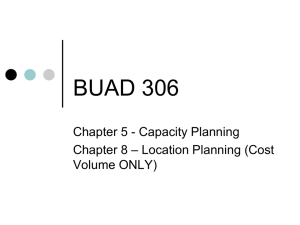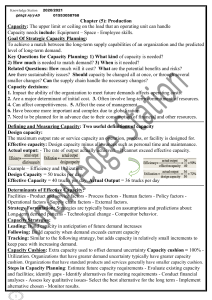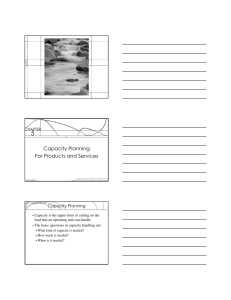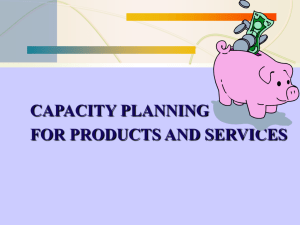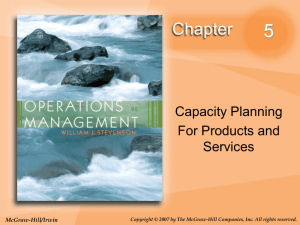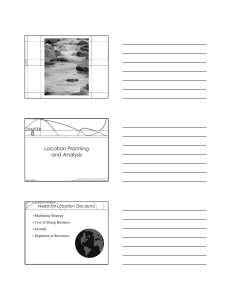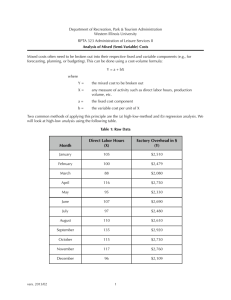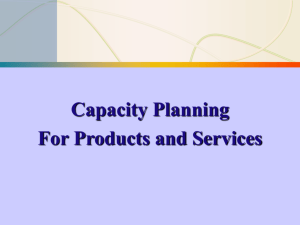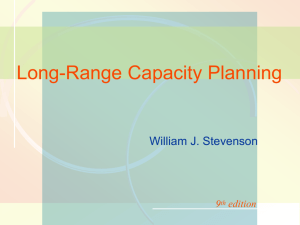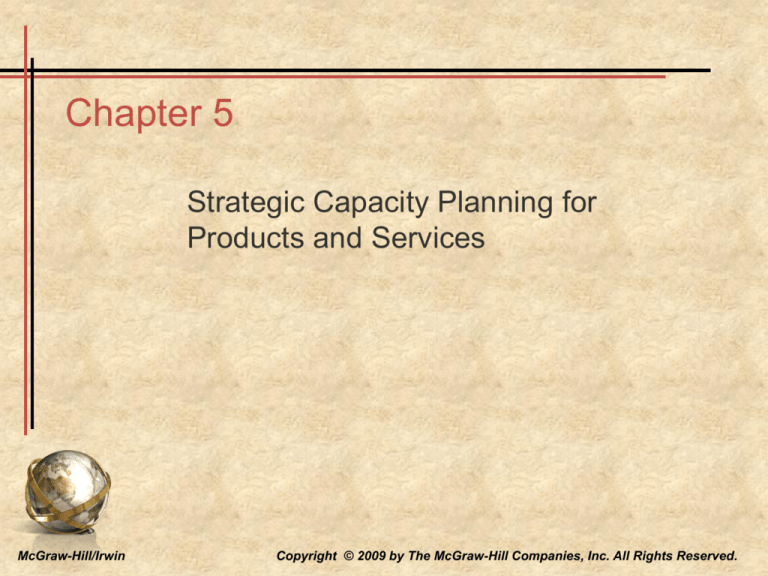
Chapter 5
Strategic Capacity Planning for
Products and Services
McGraw-Hill/Irwin
Copyright © 2009 by The McGraw-Hill Companies, Inc. All Rights Reserved.
Capacity Planning
• Capacity
– The upper limit or ceiling on the load that an operating
unit can handle
– Capacity needs include
• Equipment
• Space
• Employee skills
5-2
Strategic Capacity Planning
• Goal
– To achieve a match between the long-term supply
capabilities of an organization and the predicted level
of long-run demand
• Overcapacity operating costs that are too high
• Undercapacity strained resources and possible loss of
customers
5-3
Capacity Planning Questions
• Key Questions:
– What kind of capacity is needed?
– How much capacity is needed to match demand?
– When is it needed?
• Related Questions:
– How much will it cost?
– What are the potential benefits and risks?
– Are there sustainability issues?
– Should capacity be changed all at once, or through several
smaller changes
– Can the supply chain handle the necessary changes?
5-4
Capacity Decisions Are Strategic
• Capacity decisions
–
–
–
–
–
–
–
–
impact the ability of the organization to meet future demands
affect operating costs
are a major determinant of initial cost
often involve long-term commitment of resources
can affect competitiveness
affect the ease of management
are more important and complex due to globalization
need to be planned for in advance due to their consumption of
financial and other resources
5-5
Capacity
Design capacity
–
maximum output rate or service capacity an operation, process, or
facility is designed for
Effective capacity
–
Design capacity minus allowances such as personal time,
maintenance, and scrap
Actual output
–
rate of output actually achieved--cannot
exceed effective capacity.
5-6
Measuring System Effectiveness
• Actual output
– The rate of output actually achieved
– It cannot exceed effective capacity
• Efficiency
actual output
Efficiency
effective capacity
• Utilization
actual output
Utilizatio n
design capacity
Measured as percentages
5-7
Example– Efficiency and Utilization
• Design Capacity = 50 trucks per day
• Effective Capacity = 40 trucks per day
• Actual Output = 36 trucks per day
actual output
36
Efficiency
90%
effective capacity 40
actual output
36
Utilizatio n
72%
design capacity 50
5-8
Determinants of Effective Capacity
• Facilities
• Product and service factors
• Process factors
• Human factors
• Policy factors
• Supply chain factors
• External factors
5-9
Capacity Strategies
• Leading
– Build capacity in anticipation of future demand increases
• Following
– Build capacity when demand exceeds current capacity
• Tracking
– Similar to the following strategy, but adds capacity in relatively
small increments to keep pace with increasing demand
5-10
Strategy Formulation
• Strategies are typically based on assumptions
and predictions about:
– Long-term demand patterns
– Technological change
– Competitor behavior
5-11
Capacity Cushion
• Capacity Cushion
– Extra capacity used to offset demand uncertainty
– Capacity cushion = 100% - Utilization
– Capacity cushion strategy
• Organizations that have greater demand uncertainty
typically have greater capacity cushion
• Organizations that have standard products and services
generally have smaller capacity cushion
5-12
Steps in Capacity Planning
1.
Estimate future capacity requirements
2.
Evaluate existing capacity and facilities; identify gaps
3.
Identify alternatives for meeting requirements
4.
Conduct financial analyses
5.
Assess key qualitative issues
6.
Select the best alternative for the long term
7.
Implement alternative chosen
8.
Monitor results
5-13
Forecasting Capacity Requirements
• Long-term considerations relate to overall level
of capacity requirements
• Short-term considerations relate to probable
variations in capacity requirements
5-14
Service Capacity Planning
• Service capacity planning can present a number
of challenges related to:
– The need to be near customers
• Convenience
– The inability to store services
• Cannot store services for consumption later
– The degree of demand volatility
• Volume and timing of demand
• Time required to service individual customers
5-15
Demand Management Strategies
• Strategies used to offset capacity limitations and
that are intended to achieve a closer match
between supply and demand
– Pricing
– Promotions
– Discounts
– Other tactics to shift demand from peak periods into
slow periods
5-16
In-House or Outsource?
• Once capacity requirements are determined, the organization
must decide whether to produce a good or service itself or
outsource
• Factors to consider:
–
–
–
–
–
–
Available capacity
Expertise
Quality considerations
The nature of demand
Cost
Risks
5-17
Developing Capacity Alternatives
• Things that can be done to enhance capacity
management
–
–
–
–
–
–
–
Design flexibility
Take stage of life cycle into account
Take a “big-picture” approach to capacity changes
Prepare to deal with capacity “chunks”
Attempt to smooth capacity requirements
Identify the optimal operating level
Choose a strategy if expansion is involved
5-18
Average cost per unit
Optimal Operating Level
Minimum
cost
Optimal
Output
Rate
Rate of output
5-19
Economies of Scale
• Economies of Scale
– If output rate is less than the optimal level, increasing
the output rate results in decreasing average per unit
costs
– Reasons for economies of scale:
• Fixed costs are spread over a larger number of units
• Construction costs increase at a decreasing rate as
facility size increases
• Processing costs decrease due to standardization
5-20
Diseconomies of Scale
• Diseconomies of Scale
– If the output rate is more than the optimal level, increasing the
output rate results in increasing average per unit costs
– Reasons for diseconomies of scale
• Distribution costs increase due to traffic congestion and
shipping from a centralized facility rather than multiple smaller
facilities
• Complexity increases costs
• Inflexibility can be an issue
• Additional levels of bureaucracy
5-21
Facility Size and Optimal Operating Level
Average cost per unit
Minimum cost & optimal operating rate are
functions of size of production unit.
Small
plant
Medium
plant
Large
plant
Output rate
5-22
Constraint Management
• Constraint
– Something that limits the performance of a process or system in
achieving its goals
– Categories
• Market
• Resource
• Material
• Financial
• Knowledge or competency
• Policy
5-23
Resolving Constraint Issues
1. Identify the most pressing constraint
2. Change the operation to achieve maximum benefit,
given the constraint
3. Make sure other portions of the process are supportive
of the constraint
4. Explore and evaluate ways to overcome the constraint
5. Repeat the process until the constraint levels are at
acceptable levels
5-24
Evaluating Alternatives
• Alternatives should be evaluated from varying
perspectives
– Economic
•
•
•
•
•
Cost-volume analysis
Financial analysis
Decision theory
Waiting-line analysis
Simulation
– Non-economic
• Public opinion
5-25
Cost-Volume Analysis
• Cost-volume analysis
– Focuses on the relationship between cost, revenue,
and volume of output
• Fixed Costs (FC)
– tend to remain constant regardless of output volume
• Variable Costs (VC)
– vary directly with volume of output
– VC = Quantity(Q) x variable cost per unit (v)
• Total Cost
– TC = FC + VC
• Total Revenue (TR)
– TR = revenue per unit (R) x Q
5-26
Break-Even Point (BEP)
• BEP
– The volume of output at which total cost and total
revenue are equal
– Profit (P) = TR – TC = R x Q – (FC +v x Q)
= Q(R – v) – FC
QBEP
FC
Rv
5-27
Cost-Volume Relationships
5-28
Amount ($)
Cost-Volume Relationships
Fixed cost (FC)
0
Q (volume in units)
5-29
Amount ($)
Cost-Volume Relationships
0
BEP units
Q (volume in units)
5-30
Cost-Volume Analysis Assumptions
• Cost-volume analysis is a viable tool for comparing
capacity alternatives if certain assumptions are satisfied
–
–
–
–
One product is involved
Everything produced can be sold
The variable cost per unit is the same regardless of volume
Fixed costs do not change with volume changes, or they are step
changes
– The revenue per unit is the same regardless of volume
– Revenue per unit exceeds variable cost per unit
5-31
Cost-Volume Analysis
TC = FC + VC
Where VC = Q x variable cost/unit
TR = R x Q
P = Q (R – v) – FC
Q = P + FC
R- v
QBEP = FC
R-v
5-32
Cost-Volume Example
Problem 3, page 211
FC = $9,200
v=$.70
R=$.90
(a) What volume is needed for Breakeven?
QBEP =
FC
R-v
(b) What profit would be realized on a monthly
volume of 61,000 units? 87,000 units?
P = Q (R – v) – FC
5-33
Cost Volume Analysis
FC = $9,200/month
v=$.70/unit
R=$.90/unit
(c) What volume is needed to obtain profit of
$16,000/month?
P = Q (R – v) – FC
Q = P + FC
R- v
(d) What volume is needed to provide revenue of
$23,000/mo.?
Q = P + FC
R- v
TR = revenue per unit (R) x Q
(e) Plot the total cost and total revenue lines. Hmmm. How
do you do this? Pick different values of Q and calculate
TR & TC.
TC = FC + VC, Where VC = Q x variable cost/unit
TR = R x Q
5-34
Cost-Volume Analysis/Capacity Homework
Page 210-211
Problems 1 (a & b), 4 & 5
5-35


